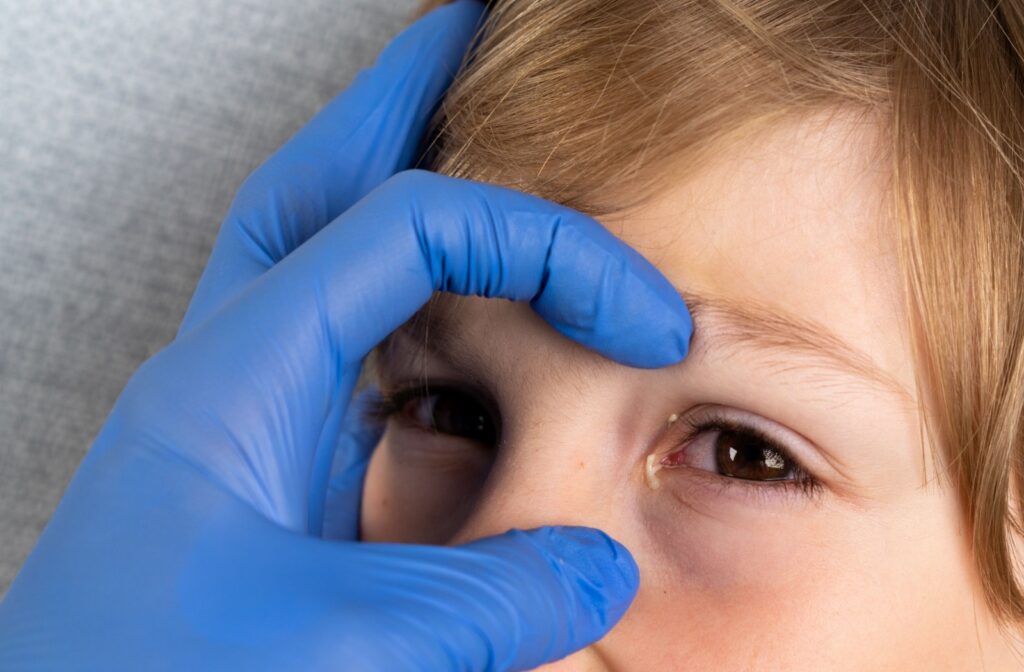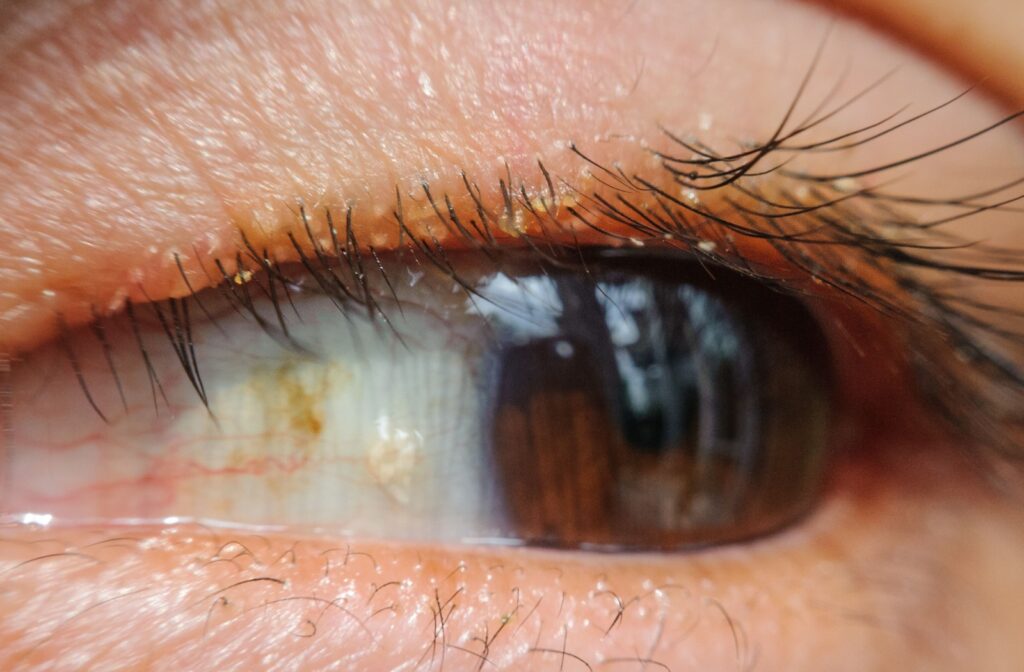Blepharitis and conjunctivitis are common eye conditions that cause redness, a burning sensation, or the feeling that something is lodged in your eye. Their symptoms are similar, so what’s the difference?
Blepharitis is a condition that affects the eyelid. Meanwhile, conjunctivitis (also known as pink eye) refers to inflammation of the conjunctiva, a thin, clear membrane that lines the inside of the eyelid and covers the white part of the eyeball (sclera).
If you experience discomfort in your eyes, consult with an optometrist. They can recommend treatments you can do at home or prescribe a medication that helps relieve symptoms.
If you experience signs of an eye emergency, contact us or go to your nearest hospital.
Basics of Blepharitis
Blepharitis refers to inflammation of the eyelid. There are 2 types of blepharitis: anterior and posterior. Anterior blepharitis is often caused by bacteria or dandruff, and sometimes, allergies or mites on the eyelashes.
Posterior blepharitis happens when the meibomian glands in the eyelids produce an abnormal amount of oil. This excess oil creates an environment that promotes bacterial growth. Posterior blepharitis may also be caused by skin conditions like scalp dandruff and rosacea.
Blepharitis Symptoms
If you have blepharitis, you may experience:
- Itchiness
- Dry eyes
- The sensation that something is lodged in your eye
- A crusty layer on your eyelids or eyelashes when you wake up
- Burning sensation
- Excessive watering or foamy tears
- Eyelids that are swollen or red
- Light sensitivity
More serious cases of blepharitis may include symptoms like blurred vision, swelling in other areas of the eye, loss of eyelashes, or eyelashes that grow in abnormal directions. Left untreated, blepharitis can also lead to more serious problems, including issues with the cornea and tear film.
However, blepharitis is not contagious. Generally, it doesn’t damage the eyes.
Basics of Conjunctivitis
Conjunctivitis is known colloquially as “pink eye.” It refers to inflammation of the conjunctiva, a thin, clear membrane that lines the inside of the eyelid and covers the white part of the eyeball (sclera). Conjunctivitis can be contagious or non-contagious. Types of conjunctivitis include:
- Allergic conjunctivitis: This type of conjunctivitis happens when a person with an allergy makes contact with their allergy trigger. It’s more common among people with seasonal allergies. One type of allergic conjunctivitis is caused by the prolonged presence of an object in the eye, and can affect people who wear contact lenses.
- Infectious conjunctivitis: This type of conjunctivitis can be caused by viruses or bacteria. Viral conjunctivitis is often linked to viruses that cause the common cold. Bacterial conjunctivitis can happen through sharing makeup or touching the eyes with unwashed hands. Ophthalmia neonatorum is a serious type of bacterial conjunctivitis that affects newborns and must be treated quickly.
- Chemical conjunctivitis: This type of conjunctivitis is caused by chemical irritants such as the chlorine used in swimming pools.
Infectious conjunctivitis can be very contagious. However, allergic and chemical conjunctivitis are not contagious.
Conjunctivitis Symptoms
People with allergic conjunctivitis may present with mildly red eyes. They may also have watery and clear discharge, and they may complain of itching.
Bacterial conjunctivitis can cause highly visible symptoms. These include more prominent redness and a yellow or green discharge. The eyelids may be red, swollen, and crusty.
Viral conjunctivitis can also cause itchy symptoms, redness, and sensitivity to light. People with viral conjunctivitis may describe their discomfort as feeling as if there’s something stuck in their eye.

Treating Blepharitis & Conjunctivitis
If you have symptoms of blepharitis or conjunctivitis, get your eyes checked out by a licensed optometrist. An accurate diagnosis is essential for appropriate treatment.
Blepharitis Treatments
There’s no cure for blepharitis, and it’s often a chronic problem. Treating blepharitis depends on the root cause, but you can often manage it by cleansing your eyelids. Your optometrist may also suggest medicated eye drops or artificial tears.
If you have a bacterial infection, your optometrist may prescribe antibiotics. If you have a health condition linked to blepharitis, such as rosacea or dandruff, treating that condition may help improve blepharitis symptoms.
Conjunctivitis Treatments
Treating conjunctivitis also depends on the underlying cause. Artificial tears and cold compresses can bring relief for allergic conjunctivitis, but more serious cases may require a prescription medication. Depending on the chemical irritant, chemical conjunctivitis may be a medical emergency.
Bacterial conjunctivitis is typically treated with antibiotics, and viral conjunctivitis often goes away on its own. To reduce the spread of infectious conjunctivitis, wash your hands frequently, don’t touch your face, dispose of cosmetic products that come near the eye (such as mascara), and don’t share personal care items like towels.
Find Eye Care in Boise, ID
Blepharitis and conjunctivitis are different conditions, but they can present similar symptoms. It’s important to get a professional diagnosis for appropriate treatment and relief of symptoms. So, if you experience symptoms of blepharitis or conjunctivitis, make an appointment with your optometrist. Founded in 1956, Vision One Boise has been a staple of our community in Boise for generations. Today, we strive to be a modern and technology-driven clinic that serves the whole family. Contact us to schedule your next eye exam.



